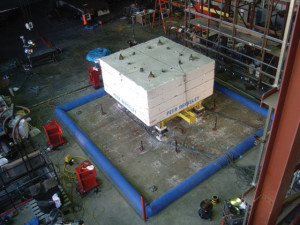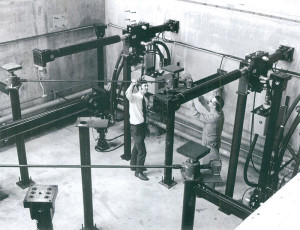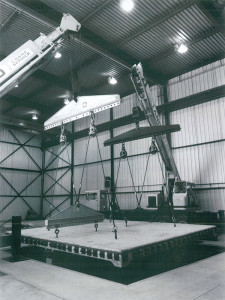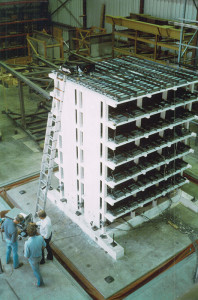In 1968, civil engineering faculty at the University of California, Berkeley (UC) proposed to construct a 100-foot by 100-foot welded steel shaking table, weighing 2.2 million pounds. It was to be hydraulically powered by 60 to 72 actuators, allowing operation in three translational degrees of freedom, with an acceleration capacity of 2/3 g. The proposed shaking table was designed to allow researchers to experimentally test and identify the earthquake behavior of large-scale structures weighing up to 4 million pounds. However, technical uncertainties and economic constraints related to then-available servo-valves, hydraulic actuators and control systems, the desired operational displacement limits of the table, and the ability to limit overturning rotation and flexure of the table, resulted in the design and construction of a prototype shaking table that would serve as a test bed to assess and improve shaking table technology. The as-built, 20-foot by 20-foot reinforced concrete shaking table was officially dedicated in 1972, shortly after the 1971 Sylmar (San Fernando) California earthquake (M6.6). Since its 1972 inauguration, the Shaking Table, located at the Richmond Field Station of UC Berkeley and managed by the Pacific Earthquake Engineering Research (PEER) Center, has been very active and continues to introduce and employ innovative technology, and carry out cutting edge research related to the seismic behavior of structures and equipment. Two images of the table during construction are shown in Figures 1 and 2.
Largest in the United States
The PEER-UC Berkeley Shaking Table was the first modern shaking table and remains the largest six-degree-of-freedom (6 DOF) Shaking Table in the United States. Although the Shaking Table was originally configured to produce only one horizontal and one vertical component of motion, currently it is able to subject test specimens to three translational components of motion: vertical and two horizontal; plus three rotational components: pitch, roll and yaw. These 6 DOF can be programmed to reproduce any waveform within the force, velocity, displacement and frequency capabilities of the Shaking Table system. The Shaking Table can subject structures to horizontal accelerations of up to 1.5g. Models up to 150,000 pounds have been successfully tested.
The Shaking Table is constructed of heavily reinforced concrete, utilizing both mild-steel reinforcement and post-tensioning tendons. Structurally, the Shaking Table may be considered as a one-foot thick diaphragm stiffened by central transverse ribs that extend below the table’s bottom surface. The eight hydraulic actuators that drive X and Y motions, along with yaw, are attached between the Shaking Table foundation and the table’s transverse ribs. The four vertical actuators which control pitch, roll and vertical displacement, are bolted between the foundation and the Shaking Table. The test structure is attached to the table by post-tensioning rods, inserted through a 3-foot by 3-foot matrix of 2-5/8-inch conduits, penetrating the Shaking Table surface. The length of the actuator assemblies, 8 feet-8 inches in the vertical direction and 10 feet-6 inches in the horizontal direction, serve to effectively de-couple the degrees of freedom motion. The high performance capabilities of the actuators, along with corrective commands provided by the sophisticated controller, complete the de-coupling. The Shaking Table itself weighs 100,000 pounds.
Testing and its Impact on Structural Engineering
The PEER-UC Berkeley Shaking Table provides the engineering community and industry the unique capability of subjecting large form factor, high mass test structures to large amplitude, simultaneous earthquake input signals in both horizontal directions (X & Y) and vertically (Z). The unique XYZ capability of the Shaking Table allows the academic community to characterize the performance of a given structure using realistic ground motions.
This shaking table ushered in a period of more complex test specimens – specimens graduated from planar models to three-dimensional models where the dynamic response (accelerations and drifts) of the assemblies are monitored in multiple directions. Testing of wood framed buildings, particularly with soft-stories, and testing of reinforced concrete model structures has been conducted. Successful experimental testing of a wide range of engineered assemblies has also taken place on the Shaking Table, including large-scale reinforced concrete frame and wall structures, multi-story steel frame structures, various types of braced frame structures, masonry buildings, tubular steel off-shore drilling platforms, bridge and dam models, piping systems, industrial and commercial racking systems, seismic dampers, soil-structure interaction of pile supported systems, and various base isolation systems for buildings, bridges and industrial storage tanks. Figure 3 shows a shear wall building model during testing.
The table was pivotal in the proof-of-concept testing of energy dissipation devices, which were not readily accepted by the structural engineering profession before the 1980s. The first test was of a steel energy-dissipating device in 1977, followed in the 1980s by rubber bearing isolators, high-damping rubber, and lead core rubber bearing isolators. These isolators were mounted on 3, 4, 5, and 9-story steel frame building models, and this testing was essential in demonstrating that the concept of energy dissipation could be beneficial to the seismic performance of the superstructure. This tested technology is designed and installed in numerous retrofits of critical-facility and landmark buildings, as well as new hospital and government buildings. Recent testing has been conducted with the devices on elevated building floors.
Friction dampers, polymeric dampers, and visco-elastic dampers were also tested in the late 1980s in building models. These devices have been designed and installed in many buildings in the United States and Canada. More recent research supported by industry led to testing of piping systems using energy dissipation support devices to reduce damage by limiting drift.
Shake table testing of steel and concrete building models led to the development of physical data and hysteretic models for cyclic behavior. Testing also contributed to the identification of dynamic effects on structural systems such as soft-story behavior, and the dynamic amplification of shear forces. Analytical models that had been developed could be calibrated with empirical testing data. Research modeling and testing that simulated the collapse of older buildings led to the development of acceptance criteria that was a predecessor to ASCE 41-13 Seismic Evaluation and Retrofit of Existing Buildings.
Seismic Qualification and Other Testing Capabilities
Additionally, the Shaking Table has been used in the seismic qualification testing of many specialized pieces of commercial and industrial equipment installed globally. The PEER-UC Berkeley Lab is accredited by the International Accreditation Service to perform panel testing in accordance with ASTM E2126, and beam-column testing and steel frame testing in accordance ANSI/AISC 341 Chapter K. The lab is also accredited to perform both AC156 and IEEE693 test protocols utilizing the Shaking Table. The simultaneous XYZ motion and high capacities of the Shaking Table allows industrial clients the capability to complete a given AC156 or IEEE693 code-compliant qualification test at the highest code required test amplitude, in a single testing configuration.
A 10-ton bridge crane services the Shaking Table lab, and the recent installation of a 19-foot by 27-foot rolling skylight installed directly above the Shaking Table allows for the testing of unlimited height structures. The unlimited testing height capability has been employed on numerous occasions to perform testing that historically has not been able to be completed due to vertical height limitations.
Recent seismic tests have included stacked wine-barrel racks (following the 2014 South Napa Earthquake), high-voltage electrical porcelain insulators, laboratory refrigerators, mechanical units, and switchgear that are components of critical function facilities.
Advanced Computational Enhancements – Hybrid Testing
PEER is again upgrading its Shaking Table. In the past, shaking tables have simply been used to reproduce as accurately as possible predetermined motions. PEER researchers have been at the forefront of developing smart or hybrid shaking table technologies, and these are now being implemented on the shaking table.
In this case, the Shaking Table platform is considered to be a part of the overall system to be tested. The platform rests on a part of the overall structure, which is represented by a finite element model. Thus, the physical part of the structure supported on the shaking table platform is shaken by, but interacts with, the numerical portion of the model. Ground motions are specified at base of finite element model. In these hybrid applications, the Shaking Table movement can represent the top surface of a foundation (for soil-structure interaction studies), bridge (for vehicle-structure interaction studies), or building systems (i.e., for investigating the effects of reactive mass or sloshing dampers on structure response). This approach permits study of specimens that are too large in their entirety to be tested experimentally on a shaking table. The approach is also an efficient means of performing parameter studies where the properties of the analytical model supporting the table are changed to represent different properties of the supporting soil or structure.
Hybrid Testing Overcomes Size Limitations of Test Specimens
Hybrid Shake Table tests provide means to dynamically test subassemblies of large systems in full-scale or near full-scale that could otherwise not be tested on a shake table due to size, weight or strength limitations imposed by the simulator platform. In general, it is beneficial to perform hybrid shake table tests instead of traditional shake table tests whenever the dynamics of the test specimen significantly affects the response of the supporting structure or soil and, therefore, alters the required input to the shake table as testing progresses.
One example application where it is advantageous to employ the Hybrid Shake Table test method is for the experimental testing of tuned mass damper (TMD) systems on tall buildings. On a traditional shake table it would be necessary to test the entire building including the TMD to correctly capture the dynamic interaction of the TMD with the building response. Employing the Hybrid Shake Table method, it is possible to model the tall building numerically in a finite element program and only test the TMD specimen experimentally.
Hybrid shaking tables are a subset of real time hybrid simulation. Implementation requires very precise control of the shaking table as well as the capability to carry out the necessary finite element analyses in real time. To accomplish this, the PEER-developed open-source FRamework for Experimental Setup and COntrol (OpenFRESCO) and the open-source System for Earthquake Engineering Simulation (OpenSEES) have been installed in a set of multi-core high performance computers and linked to the shaking table’s controller by means of a real time shared memory network. During a hybrid simulation, OpenSees is used to compute the absolute displacements (and/or accelerations and/or velocities) at the location of the shaking table platform in the numerical model for each step in the response history analysis, and these results are used to control the shake table platform in real time. At the same time, forces at the base of the test specimen are measured in real time and fed back into the numerical model at the virtual interface between the numerical model and Shaking Table platform. This means that the numerical analysis needs to be performed in real time to drive the shake table platform on the fly and produce accurate displacement, velocity and acceleration histories at the interface between the numerical model and the experimental specimen.
The advantage of this approach is that the dynamic behavior of both the numerically modeled structure and the experimental specimen are being captured correctly. Furthermore, only the TMD specimen needs to be tested on the shake table instead of the entire tall building. Specimens can therefore be tested at full- or large-scale, and much more economically. If the test specimen on the shake table is nondestructive, such as a response modification device (TMD, seismic isolation, or damper), the Hybrid Shake Table test method also allows for performing a wide range of building parameter studies by simply changing the finite element model of the numerical portion of the structure before conducting another test. See Figure 4 for the testing of a TMD.

Figure 4. Hybrid testing of tuned mass damper (TMD) system. Load cells and isolators are located under corners of the blocks under the yellow frame. The TMD is assumed to be on top of a tall building.
Hence, the PEER-UC Berkeley Shaking Table, with its newly developed advance hybrid simulation capabilities, provides a unique opportunity to test large and complex systems, where test specimens dynamically interact with supporting structures, foundations or soils that would not be possible otherwise. Future upgrades include the ability to incorporate auxiliary actuators connected to different points within a test specimen or between the specimen and fixed points located on or off of the platform.
The Shaking Table is used by researchers, industry, and design professionals worldwide. For more information about the Shaking Table capabilities, conducting research using the table, or testing for seismic qualifications, visit the PEER website at or contact the PEER center.
All graphics courtesy of NISEE-PEER.



